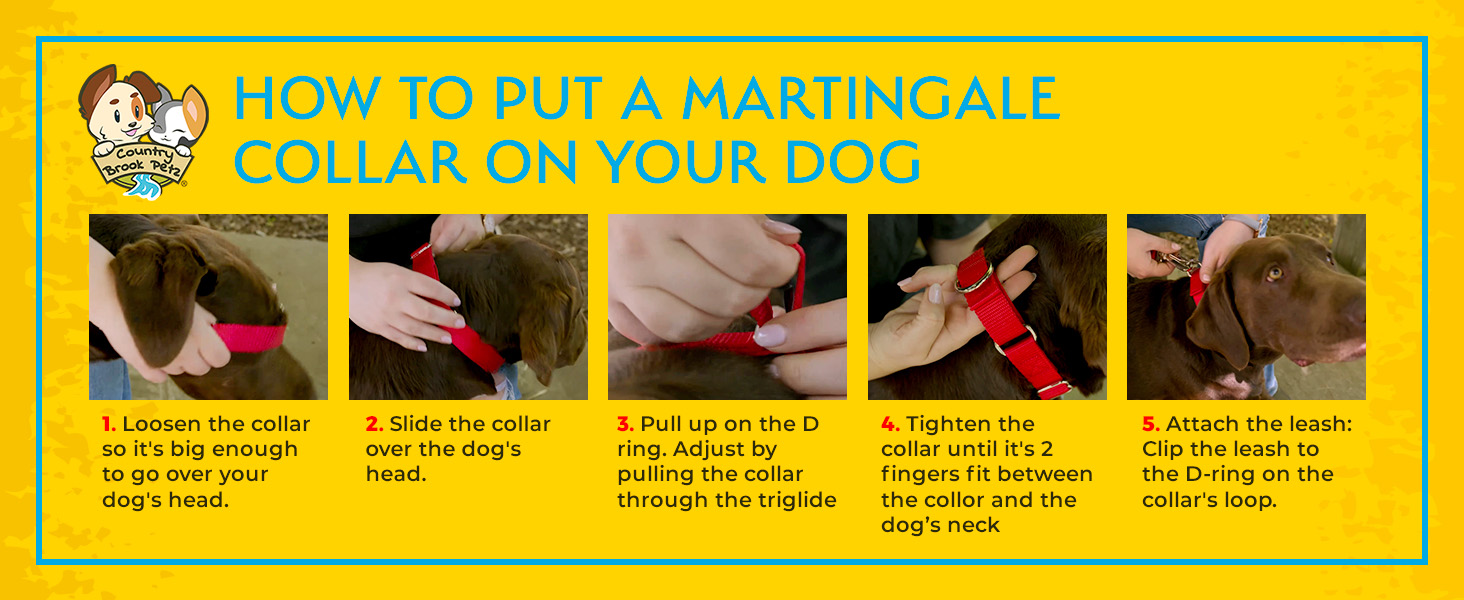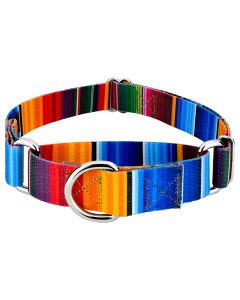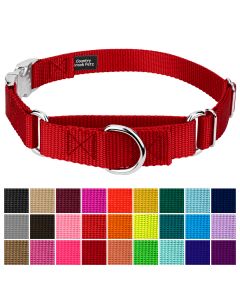The Famous Martingale Collar
Martingale dog collars, often referred to as limited-slip collars, are designed to provide more control and prevent dogs from slipping out of their collars, all while avoiding the choking risk that comes with traditional choke chains. These collars tighten slightly when a dog pulls, providing gentle but effective feedback without causing any harm to your pup. Choosing the right martingale collar can significantly benefit your dog by enhancing the effectiveness of your training, ensuring safety during walks, and providing comfort. Choosing a collar that fits properly and suits your dog's size and behavior can improve their overall experience and well-being.
What Exactly are Martingale Dog Collars?

Martingale dog collars (also known as limited-slip collars) are designed to provide gentle control by tightening slightly when your dog pulls, preventing them from slipping out while avoiding the choking risk that comes with choke chains. Unlike standard collars, which stay the same size regardless of the dog's behavior, martingale collars have a unique design with a limited-slip feature that provides a secure and comfortable fit. The collars started in the world of sighthound owners who needed a reliable collar for their dogs' slim heads. Martingale collars have become popular among various breeds for their effectiveness in training and safety. This specialized collar design offers a humane alternative to more restrictive collars, making it a preferred choice for owners of any dog breed.
The Benefits of a Martingale Dog Collar

These collars offer several different benefits, making them a valuable choice for dog owners while training. Their safety feature ensures that dogs cannot slip out, providing peace of mind during walks and other outdoor activities. The gentle tightening mechanism offers enhanced control without causing discomfort or harm, making it easier to manage dogs that tend to pull when overly excited. Comfort is a key advantage, as the collar distributes pressure evenly around the neck rather than just the front of the throat, preventing the choking and discomfort associated with traditional collars. Additionally, martingale collars are incredibly versatile, suitable for various dog breeds and sizes, and can be used in multiple settings. From casual walks to more structured training sessions, these collars are a perfect choice. As a training aid, they provide effective feedback to your dog, promoting better behavior and making training smoother for both you and your furbaby.
How To Use a Martingale Dog Collar
Using a martingale dog collar correctly involves proper fitting and adjustments to ensure and maximize both safety and effectiveness. To begin, adjust the collar to fit snugly but comfortably around your dog's neck when pulled. You should be able to fit two fingers between the collar and the dog's neck before testing the tightening mechanism. When introducing your dog to the collar, initially let them wear it for short periods, paired with positive reinforcement like treats and praise to create a positive association. When using a martingale collar, ensure it's only used during supervised activities. Never leave it on an unsupervised dog, as there's a chance of risks such as choking, injury, stress, and unintended tightening. Avoid using it as a tie-out collar or pulling it too tightly. Proper use of a martingale collar can enhance control and safety while keeping your dog comfortable and well-trained.


How to put on a Martingale Collar
- Step One: Loosen the collar so it's big enough to go over your dog's head
- Step Two: Slide the Collar over your dog's head
- Step Three: Pull up on the D-Ring. Adjust by pulling the collar through the triglide
- Step Four: Tighten the collar until it's two fingers fit between the collar and the dog's neck
- Step Five: Attach the leash: Clip the leash to the D-Ring on the collar's loop
Why Consider a Martingale Dog Collar?

If you have a dog with a more narrow head, such as a Greyhound or Whippet, their slim necks can easily slip out of traditionally styled collars, so a martingale would be the best option. These collars are especially beneficial for dogs that frequently escape from standard collars when walking, providing a more secure fit when your pup gets over-excited. For owners seeking a more humane training tool, martingale collars offer gentle correction without the harshness of choke chains, making them ideal for training. Additionally, if your dog tends to pull or lunge during walks, the martingale collar can provide better control and reduce the strain on both you and your dog, making walks more enjoyable and safe for the both of you. This collar is a great choice for enhancing your dog's training, safety, and overall walking experience.
Choosing Your Martingale Dog Collar
Choosing the right martingale collar involves different factors to consider, such as size, material, and design. First, ensure you select the appropriate size for your dog by measuring around their neck and choosing a collar that fits comfortably when adjusted. We offer sizes from Extra Large all the way down to 3XS, as seen on the size chart below.
The material is also important; nylon is durable, easy to clean, and offers several color options, while polyester, also durable and easy to clean, offers a more stylish option using colorfast dye to avoid color bleeding. Additionally, some collars come with added features like reflective stitching for nighttime visibility. When it comes to choosing a design, opt for a collar with a secure yet comfortable tightening mechanism. We offer several different design options, so you'll find the perfect one for your furbaby to show their style.
For different breeds and sizes, lightweight, narrow collars are suitable for small breeds or those with delicate necks, while wider, sturdier collars are better for larger breeds or those that pull more forcefully. Considering all of these factors will help you select a martingale collar that ensures your dog's safety, comfort, and effectiveness.


Conclusion





